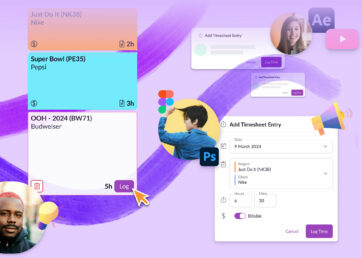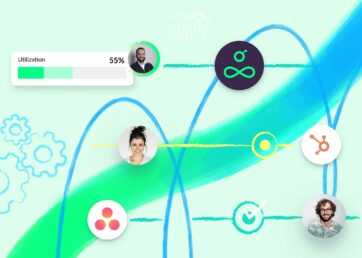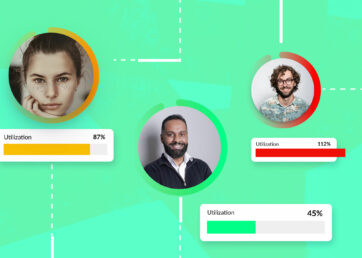Does thinking about the health of your agency keep you up at night? We don’t blame you. Running an agency is no easy feat during the best of times. In today’s world—it’s a different kind of beast.
As consumer habits, cancel culture, and economic uncertainty all challenge the livelihood of brands and agencies worldwide, it’s time to rethink agency efficiency—for good.
In this article 📖
What is operational efficiency for agencies?
Operational efficiency refers to the ability to maximize the agency’s resources to achieve its goals with minimal waste.
In other words, it’s about making sure that everyone in your agency is working together effectively to produce high-quality work that meets (or exceeds) client expectations.
By improving the overall efficiency of your agency operations, you can increase profitability, reduce stress, and set your agency up for long-term success.
Why is efficiency so important to agencies?
You’re probably here because you already understand the importance of operational efficiency: it directly impacts your agency’s bottom line.
When an agency is operationally efficient, it can complete projects more quickly and with fewer resources. As a result, it means it can take on more work and increase its revenue. It’s simple math.
So how can you improve agency efficiency? It starts with understanding the numbers.
10 agency efficiency metrics to keep in mind
We’re going to start by telling you something you don’t want to hear: Efficiency metrics are going to vary. Why? They depend on the specific business goals and nature of the agency.
But the good news is that all agencies will have a set of metrics in common.
These agency efficiency metrics can be split into two categories:
- Financial (F), for example:
-
-
- Agency Gross Income (AGI)
- Delivery margins
-
- Non-financial (N-F), for example:
-
- Billable utilization rates
- Customer health data
Let’s take a look at the key metrics in each category:
-
- Agency Gross Income (F): This represents the total income generated by an agency after subtracting direct costs associated with serving clients. It paints a clear picture of the actual income the agency generates from its operations before overheads and indirect costs such as rent, administrative salaries, utilities, and other expenses have been taken into account.
- Delivery margin (F): This is a crucial profitability metric that determines the percentage of profit left after deducting delivery costs from your revenue, also known as Agency Gross Income (AGI).How to calculate your delivery margin: Delivery margin = (AGI – delivery expenses) / AGI

- Overhead costs (F): This metric shows the percentage of your costs that goes towards overhead expenses like rent, utilities, and administrative staff. Lower overhead rates can often indicate higher operational efficiency.
- Project profitability (F): This measures the revenue a project generates, minus the costs associated with completing the project (including staff time, outsourced work, and other expenses).
- Time to complete projects (N-F): The speed at which your agency can complete projects, particularly when compared to initial estimates, can be a good indicator of operational efficiency.
- Billable utilization rate (N-F): This is the percentage of total hours worked that can be billed to clients. A higher rate indicates that your team is spending more of their time on revenue-generating activities.
- Client retention rate (N-F): High client retention rates can suggest that your agency is doing well at keeping clients happy and providing value, which contributes to operational efficiency.
- Employee turnover rate (N-F): High turnover can be a sign of inefficiencies and problems within your organization, such as overwork, poor management, or low morale.
- Revenue per employee (N-F): This metric gives you a sense of how much each staff member contributes to your agency’s revenue. Higher revenue per employee suggests higher operational efficiency.
- Cost-per-Acquisition (N-F): Cost-per-acquisition (CPA) measures how much it costs your agency to acquire a new client. Lower CPAs can indicate more efficient sales and marketing processes.
With these metrics top of mind, let’s take a look at what you can do to improve agency efficiency.
💡 Your delivery margin can also inform decision-making around resource allocation and other aspects of agency project management.
5 things you can do to boost agency efficiency (starting today)
Let’s look at some of the most practical steps you can take toward improving your agency’s operational efficiency.
1. Understand the numbers
Like most things, agency efficiency is a numbers game.
But that game starts with truly understanding the numbers and making sure you can easily access, digest, and share them with key stakeholders such as investors, partners, and other members of the leadership team.
To drive agency efficiency, you’ll need full visibility on:
- Key financial data
- Project performance metrics
- Customer health metrics (such as NPS score)
- Employee data (such as productivity and health metrics)
With that said, it’s time to review your agency tech stack and make sure your data is in the right place.
2. Audit your agency tech stack
So you’ve got a firm grip on the numbers, but are they in the right place and does the data flow seamlessly between systems?
Give your tech stack a thorough audit (ideally alongside a data engineer or analyst) to help you make sure your data is both accurate and reliable. After all, what’s the point of reporting, if the numbers aren’t right?
Make sure you:
- Assess overall functionality
- Look at integration capabilities
- Assess usability
Going tool crazy is expensive and creates confusion and the need for more (potentially unnecessary) SOPs. Don’t want to have expensive tech debt? Keep your tech stack lean, functional, and user-friendly.
3. Optimize agency workflows
Workflows aren’t a set-it-and-forget-it kind of thing, you need to continuously monitor and improve them to make sure they lead to higher output quality. By doing so, you’re more likely to have both happy teams—and happy clients.
Start by:
- Reviewing existing workflows
- Identifying bottlenecks
- Streamlining and simplifying
Remember, don’t be afraid to throw things that don’t work out the window. Rebuilding workflows is better than putting on bandaids.
Read: Your guide to agency workflows (featuring an 8-step agency workflow process)
4. Improve project management processes
Some of the biggest time and money pits for a service-based business can be found in the day-to-day operational processes. Repetitive administration tasks and non-billable work take time away from projects that can’t be recovered.
In other words, it’s time to take a look at your processes. Ask yourself:
- Are your processes fully understood by team members?
- Are your processes easy to follow?
- Are your processes helping you to effectively allocate resources?
- Do your processes help project teams work seamlessly across the project lifecycle?
Read: Agency project management process: 9 steps to higher profits (and happier clients)
5. Review resource planning practices
Resource planning is crucial when it comes to improving agency efficiency. You don’t want to cause project delays due to resource overallocation and you don’t want to pay for underutilized resources, such as costly freelancers.
Get on top of your resource management function by:
- Analyzing utilization reports
- Identifying gaps in skills and experience
- Reviewing resource costs
Efficient resource planning ensures that resources are neither overworked nor underused. This balance is important to maintain the quality of work (keeping clients happy) and prevent burnout in team members.
Read: Agency resource planning and management guide
Drive growth with consistent agency efficiency practices
To say that the agency sector is competitive would be an understatement. It’s a dog-eat-dog world out there, and staying ahead of the curve when it comes to growth strategy is key for any successful agency that wants to ensure its profitability.
Optimizing for operational efficiency isn’t just a one-time thing. The work never ends when it comes to improving agency efficiency and optimizing for continued growth.
By continuously monitoring and measuring your agency efficiency metrics, you can identify areas for improvement and implement best practices that will make sure your agency doesn’t just survive—but thrive.





